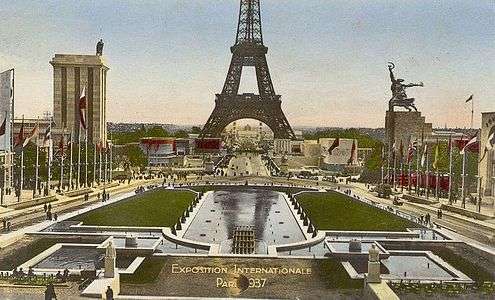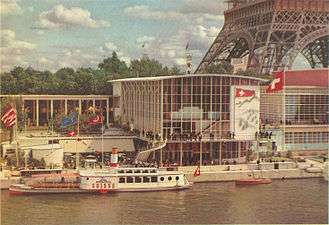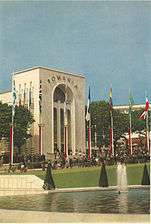Exposition Internationale des Arts et Techniques dans la Vie Moderne
| EXPO Paris 1937 | |
|---|---|
 The Eiffel tower, with the German pavilion on left and the Soviet pavilion on the right | |
| Overview | |
| BIE-class | Universal exposition |
| Category | Second category General Exposition |
| Name | Exposition Internationale des Arts et des Techniques appliqués à la vie moderne |
| Building | Palais de Chaillot |
| Area | 101 hectares (250 acres) |
| Visitors | 31,040,955 |
| Participant(s) | |
| Countries | 44 |
| Location | |
| Country | France |
| City | Paris |
| Venue | Trocadéro, Champ-de-Mars, Embankment of the Seine |
| Coordinates | 48°51′44″N 02°17′17.7″E / 48.86222°N 2.288250°E |
| Timeline | |
| Opening | 25 May 1937 |
| Closure | 25 November 1937 |
| Universal expositions | |
| Previous | Brussels International Exposition (1935) in Brussels |
| Next | 1939 New York World's Fair in New York City |
| Specialized Expositions | |
| Previous | ILIS 1936 in Stockholm |
| Next | Second International Aeronautic Exhibition in Helsinki |
The Exposition Internationale des Arts et Techniques dans la Vie Moderne (International Exposition of Art and Technology in Modern Life) was held from 25 May to 25 November 1937 in Paris, France. Both the Musée de l'Homme and the Palais de Tokyo, which houses the Musée d'Art Moderne de la Ville de Paris, were created for this exhibition.
Exhibitions
At first the centerpiece of the exposition was to be a 2,300-foot (700 m) tower ("Phare du Monde") which was to have a spiraling road to a parking garage located at the top and a hotel and restaurant located above that. The idea was abandoned as far too expensive.[1]
Fitting in the architectural master-plan of the master architect Jacques Gréber at the foot of the Eiffel Tower, and inspired by the shape of a grain elevator, the Canadian pavilion included Joseph-Émile Brunet's 28-foot sculpture of a buffalo (1937). Paintings by Brunet, sculpted panels on the outside of the structure, and several thematic stands inside the Canadian pavilion depicted aspects of Canadian culture.[2]
The Spanish pavilion attracted attention as the exposition took place during the Spanish Civil War. The Spanish pavilion was built by the Spanish architect Josep Lluis Sert.[3] The pavilion, set up by the Republican government, included Pablo Picasso's famous painting Guernica,[4] a depiction of the horrors of war, Alexander Calder's sculpture Mercury Fountain and Joan Miró's painting Catalan peasant in revolt.[5]
Two of the other notable pavilions were those of Nazi Germany and the Soviet Union. The organization of the world exhibition had placed the German and the Soviet pavilions directly across from each other.[6] Hitler had desired to withdraw from participation, but his architect Albert Speer convinced him to participate after all, showing Hitler his plans for the German pavilion. Speer later revealed in his autobiographies that he had had a clandestine look at the plans for the Soviet pavilion, and had designed the German pavilion to represent a bulwark against Communism.
The preparation and construction of the exhibits were plagued by delay. On the opening day of the exhibition, only the German and the Soviet pavilions had been completed. This, as well as the fact that the two pavilions faced each other, turned the exhibition into a competition between the two great ideological rivals.
Speer's pavilion was culminated by a tall tower crowned with the symbols of the Nazi state: an eagle and the swastika. The pavilion was conceived as a monument to "German pride and achievement". It was to broadcast to the world that a new and powerful Germany had a restored sense of national pride. At night, the pavilion was illuminated by floodlights. Josef Thorak's sculpture Comradeship stood outside the pavilion, depicting two enormous nude males, clasping hands and standing defiantly side by side, in a pose of mutual defense and "racial camaraderie".[6]

The architect of the Soviet pavilion was Boris Iofan. Vera Mukhina designed the large figurative sculpture on the pavilion. The grand building was topped by Worker and Kolkhoz Woman, a large momentum-exerting statue, of a male worker and a female peasant, their hands together, thrusting a hammer and a sickle. The statue was meant to symbolize the union of workers and peasants.[6]
Britain had not been expecting such a competitive exposition, and its planned budget was only a small fraction of Germany's.[7] Frank Pick, the chairman of the Council for Art and Industry, appointed Oliver Hill as architect but told him to avoid modernism and to focus on traditional crafts.[8] The main architectural element of Hill's pavilion was a large white box, decorated externally with a painted frieze by John Skeaping and internally with giant photographic figures which included Neville Chamberlain fishing. Its contents were crafts objects arranged according to English words which had become loanwords in French, such as "sport" and "weekend". There was considerable British criticism that the result was unrepresentative of Britain and compared poorly to the other pavilions' projections of national strength.[7]
Awards
- At the presentation, both Speer and Iofan, who also designed the Palace of Soviets that was planned to be constructed in Moscow, were awarded gold medals for their respective designs. Also, for his model of the Nuremberg party rally grounds, the jury granted Speer, to his and Hitler's surprise, a Grand Prix.[9]
- Artist Johanne deRibert Kajanus, mother of composer Georg Kajanus and film-maker Eva Norvind, granddaughter of composer and conductor Robert Kajanus, and grandmother of actress Nailea Norvind, won a bronze medal for her life-size sculpture of Mother and Child at the exhibition.
- Polish engineers from Warsaw won a gold medal for the new Polish locomotive Pm36-1 PKP class Pm36.
- American architect Alden Dow won the "grand prize for residential architecture" for his John S. Whitman House, built in Midland, Michigan, USA.[10]
- Soviet architect Andrey Kryachkov won the Grand Prix for designing his 100-flat building located in Novosibirsk.
- German textile designer, weaver and former Bauhaus student Margaretha Reichardt (1907-1984) won an honorary diploma for her Gobelin tapestry.[11]
Festivals of the Exposition
- 23 May — The Centenary of the Arc de Triomphe
- 5 – 13 June — The International Floralies
- 26 June — Motorboat races on the Seine
- 29 June — Dance Festival
- July — Midsummer Night's Dream (In the gardens of Bagatelle)
- 3 July — Horse Racing
- 4 – 11 July — Rebirth of the City
- 21 July — Colonial Festival
- 27 July — World Championship Boxing Matches
- 30 July – 10 August — The True Mystery of the Passion (before Notre Dame Cathedral)
- 12 September — Grape Harvest Festival
- Forty Two International Sporting Championships
- Every Night: Visions of Fairyland on the Seine
Reproduction of the Soviet pavilion
After the Paris exhibition closed, Worker and Kolkhoz Woman was moved to the entrance of the All-Russia Exhibition Centre in Moscow, where it stood on a high platform. In 2007 the Russian government decided to create a reproduction of the Soviet pavilion, with the sculpture placed on top. This was inaugurated in 2009.
Gallery
 The Nazi German pavilion
The Nazi German pavilion.jpg) The Soviet pavilion
The Soviet pavilion The Swiss pavilion
The Swiss pavilion The Romanian pavilion
The Romanian pavilion_(15970160408).jpg) The Soviet pavilion reproduced in Moscow
The Soviet pavilion reproduced in Moscow
See also
- Nazi architecture
- Stalinist architecture
- Streamline Moderne architecture
Further reading
- World's Fairs on the Eve of War: Science, Technology, and Modernity, 1937-1942 by Robert H. Kargon and others, 2015, University of Pittsburgh Press
References
- ↑ "Tower Nearly A Half Mile High To Have Spiral Road", July 1933, Popular Mechanics
- ↑ Evrard, Guillaume (2010) “Producing and Consuming Agricultural Capital: The Aesthetics and Cultural Politics of Grain Elevators at the 1937 Paris International Exposition” in Balfour, Robert J. (ed.) Culture, Capital and Representation. Basingstoke: Palgrave-Macmillan. pp. 148-68 ISBN 978-0-230-29119-5
- ↑ ...the Spanish Pavilion PBS. Retrieved 15 October 2012
- ↑ Beevor, Antony. (2006). The Battle for Spain. The Spanish Civil War, 1936-1939. Penguin Books. London. p.249
- ↑ http://www.bib.ub.edu/en/libraries/pavello-republica/expos/pavello-republica/ Archived 7 July 2010 at the Wayback Machine.
- 1 2 3 R. J. Overy (30 September 2004). The Dictators: Hitler's Germany, Stalin's Russia. W. W. Norton & Company. ISBN 978-0-393-02030-4.
- 1 2 Crinson, Mark (2004). "Architecture and 'national projection' between the wars". In Arnold, Dana. Cultural Identities and the Aesthetics of Britishness. Manchester: Manchester University Press. pp. 191–194. ISBN 0-7190-6768-5.
- ↑ Saler, Michael T. (1999). The Avant-Garde in Interwar England : Medieval Modernism and the London Underground. Oxford: Oxford University Press. pp. 158–159. ISBN 0-19-514718-9.
- ↑ Fest, Joachim. Speer p.88 (English edition)
- ↑ Robinson, Sidney K., ‘’The Architecture of Alden B. Dow,’’ Wayne State University Press, Detroit, MI 1983 p. 45
- ↑ Margaretha Reichardt. Bauhaus100. Available at: https://www.bauhaus100.de/en/past/people/students/margaretha-reichardt/ (Accessed: 27 November 2016)
External links
| Wikimedia Commons has media related to Exposition Internationale des Arts et Techniques dans la Vie Moderne. |
- Exposition Internationale de 1937 Photographs
- Exposition Internationale by Sylvain Ageorges (French)
- Traces of the Exposition
- International Exposition of Arts and Technics in modern life